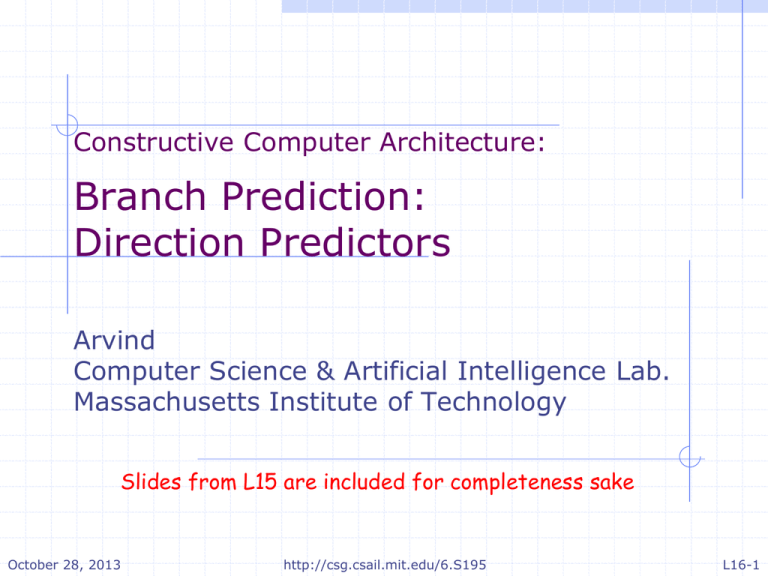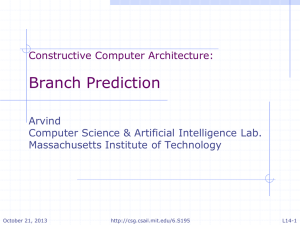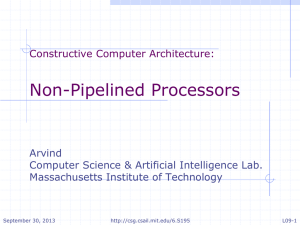pptx - Computation Structures Group
advertisement

Constructive Computer Architecture:
Branch Prediction:
Direction Predictors
Arvind
Computer Science & Artificial Intelligence Lab.
Massachusetts Institute of Technology
Slides from L15 are included for completeness sake
October 28, 2013
http://csg.csail.mit.edu/6.S195
L16-1
Contributors to the course
material
Arvind, Rishiyur S. Nikhil, Joel Emer,
Muralidaran Vijayaraghavan
Staff and students in 6.375 (Spring 2013),
6.S195 (Fall 2012), 6.S078 (Spring 2012)
Asif Khan, Richard Ruhler, Sang Woo Jun, Abhinav
Agarwal, Myron King, Kermin Fleming, Ming Liu, LiShiuan Peh
External
October 28, 2013
Prof
Prof
Prof
Prof
Amey Karkare & students at IIT Kanpur
Jihong Kim & students at Seoul Nation University
Derek Chiou, University of Texas at Austin
Yoav Etsion & students at Technion
http://csg.csail.mit.edu/6.S195
L16-2
Multiple Predictors: BTB +
Branch Direction Predictors
mispred
insts
must be
filtered
Next Addr
Pred
tight
loop
P
C
Need
next PC
immediately
Br Dir
Pred
correct
mispred
Decode
Reg
Read
Instr type,
PC relative
targets
available
Simple
conditions,
register targets
available
correct
mispred
Execute
Write
Back
Complex
conditions
available
Suppose we maintain a table of how a particular Br has
resolved before. At the decode stage we can consult this
table to check if the incoming (pc, ppc) pair matches
our prediction. If not redirect the pc
October 28, 2013
http://csg.csail.mit.edu/6.S195
L16-3
Branch Prediction Bits
Remember how the branch was resolved previously
• Assume 2 BP bits per instruction
• Use saturating counter
On taken
On ¬taken
1
1
Strongly taken
1
0
Weakly taken
0
1
Weakly ¬taken
0
0
Strongly ¬taken
Direction prediction changes only after two successive
bad predictions
October 28, 2013
http://csg.csail.mit.edu/6.S195
L16-4
Two-bit versus one-bit
Branch prediction
Consider the branch instruction needed to
implement a loop
with one bit, the prediction will always be set
incorrectly on loop exit
with two bits the prediction will not change on loop
exit
A little bit of hysteresis is good in changing predictions
October 28, 2013
http://csg.csail.mit.edu/6.S195
L16-5
Branch History Table (BHT)
from
Fetch
Instruction
Opcode
Fetch PC
offset
00
k
+
Branch?
BHT Index
Target PC
After decoding the instruction if it turns out
to be a branch, then we can consult BHT
using the pc; if this prediction is different
from the incoming ppc we can redirect
Fetch
2k-entry
BHT,
2 bits/entry
Taken/¬Taken?
4K-entry BHT, 2 bits/entry, ~80-90% correct
direction predictions
October 28, 2013
http://csg.csail.mit.edu/6.S195
L16-6
Where does BHT fit in the
processor pipeline?
BHT can only be used after instruction decode
We still need the next instruction address
predictor (e.g., BTB) at the fetch stage
Predictor training: On a pc misprediction,
information about redirecting the pc has to be
passed to the fetch stage. However for
training branch predictors information has to
be passed even when there is no misprediction
October 28, 2013
http://csg.csail.mit.edu/6.S195
L16-7
2-Stage-DH pipeline
doExecute rule
Even if there is no
rule doExecute;
misprediction, send
let x = d2e.first;
let dInst = x.dInst; let pc
= x.pc;
information about
let ppc
= x.ppc;
let epoch = x.epoch;
branch resolution for
let rVal1 = x.rVal1; let rVal2 = x.rVal2;
training predictors
if(epoch == eEpoch) begin
let eInst = exec(dInst, rVal1, rVal2, pc, ppc);
if(eInst.iType == Ld) eInst.data <dMem.req(MemReq{op:Ld, addr:eInst.addr, data:?});
else if (eInst.iType == St) let d <dMem.req(MemReq{op:St, addr:eInst.addr, data:eInst.data});
if (isValid(eInst.dst))
rf.wr(validRegValue(eInst.dst), eInst.data);
if(eInst.mispredict) begin
redirect.enq(RedirectInfo{pc: pc, nextPc: eInst.addr,
taken: eInst.brTaken);
eEpoch <= !eEpoch; end
end
d2e.deq; sb.remove;
endrule
October 28, 2013
http://csg.csail.mit.edu/6.S195
L16-8
2-Stage-DH pipeline
doExecute rule:
predictor training
Even if there is no
rule doExecute;
misprediction, send
let x = d2e.first;
let dInst = x.dInst; let pc
= x.pc;
information about
let ppc
= x.ppc;
let epoch = x.epoch;
branch resolution for
let rVal1 = x.rVal1; let rVal2 = x.rVal2;
training predictors
if(epoch == eEpoch) begin
let eInst = exec(dInst, rVal1, rVal2, pc, ppc);
if(eInst.iType == Ld) eInst.data <dMem.req(MemReq{op:Ld, addr:eInst.addr, data:?});
else if (eInst.iType == St) let d <dMem.req(MemReq{op:St, addr:eInst.addr, data:eInst.data});
if (isValid(eInst.dst))
rf.wr(validRegValue(eInst.dst), eInst.data);
if(eInst.mispredict)
if(eInst.mispredict) eEpoch
begin <= !eEpoch;
if(eInst.iType
== J || eInst.iType
Jr || eInst.iType
redirect.enq(RedirectInfo{pc:
pc,==nextPc:
eInst.addr, == Br)
redirect.enq(Redirect{pc:
pc, nextPc: eInst.addr,
taken: eInst.brTaken);
taken:
eInst.brTaken,
mispredict: eInst.mispredict,
eEpoch
<= !eEpoch;
end
brType: eInst.iType});
end
d2e.deq;
d2e.deq; sb.remove;
sb.remove;
endrule
endrule
October 28, 2013
http://csg.csail.mit.edu/6.S195
L16-9
2-Stage-DH pipeline
doFetch rule:
rule doFetch;
update nap but change pc
let inst = iMem.req(pc);
only on a mispredict
if(redirect.notEmpty) begin
fEpoch <= !fEpoch; pc <= redirect.first.nextPC;
redirect.deq; nap.update(redirect.first); end
else begin
let ppc = nap.predPC(pc); let dInst = decode(inst);
let stall = sb.search1(dInst.src1)|| sb.search2(dInst.src2);
if(!stall)
begin
let rVal1 = rf.rd1(validRegValue(dInst.src1));
let rVal2 = rf.rd2(validRegValue(dInst.src2));
d2e.enq(Decode2Execute{pc: pc, nextPC: ppc,
dIinst: dInst, epoch: fEpoch,
rVal1: rVal1, rVal2: rVal2});
sb.insert(dInst.rDst); pc <= ppc; end
end
endrule
October 28, 2013
http://csg.csail.mit.edu/6.S195
L16-10
2-Stage-DH pipeline
doFetch rule:
predictor training
rule doFetch;
update nap but change pc
let inst = iMem.req(pc);
only on a mispredict
if(redirect.notEmpty) begin
fEpoch <= !fEpoch; pc <= redirect.first.nextPc;
redirect.deq; nap.update(redirect.first); end
if(redirect.notEmpty && redirect.first.mispredict)
begin pc <= redirect.first.nextPc; fEpoch <= !fEpoch; end
else begin
let ppc = nap.predPC(pc); let dInst = decode(inst);
let stall = sb.search1(dInst.src1)|| sb.search2(dInst.src2);
if(!stall)
begin
let rVal1 = rf.rd1(validRegValue(dInst.src1));
let rVal2 = rf.rd2(validRegValue(dInst.src2));
d2e.enq(Decode2Execute{pc: pc, nextPC: ppc,
dIinst: dInst, epoch: fEpoch,
rVal1: rVal1, rVal2: rVal2});
sb.insert(dInst.rDst); pc <= ppc; end
end
endrule
October 28, 2013
http://csg.csail.mit.edu/6.S195
L16-11
Multiple predictors in a
pipeline
At each stage we need to take two decisions:
Whether the current instruction is a wrong path
instruction. Requires looking at epochs
Whether the prediction (ppc) following the current
instruction is good or not. Requires consulting the
prediction data structure (BTB, BHT, …)
Fetch stage must correct the pc unless the
redirection comes from a known wrong path
instruction
Redirections from Execute stage are always
correct, i.e., cannot come from wrong path
instructions
October 28, 2013
http://csg.csail.mit.edu/6.S195
L16-12
Dropping or poisoning an
instruction
Once an instruction is determined to be on the
wrong path, the instruction is either dropped or
poisoned
Drop: If the wrong path instruction has not
modified any book keeping structures (e.g.,
Scoreboard) then it is simply removed
Poison: If the wrong path instruction has
modified book keeping structures then it is
poisoned and passed down for book keeping
reasons (say, to remove it from the scoreboard)
Subsequent stages know not to update any
architectural state for a poisoned instruction
October 28, 2013
http://csg.csail.mit.edu/6.S195
L16-13
recirect
N-Stage pipeline – BTB only
fEpoch
attached to
every fetched
instruction
{pc, newPc, taken
mispredict, ...}
eEpoch
miss
pred?
BTB
{pc, ppc, epoch}
Fetch
PC
f2d
Decode
d2e
Execute
...
At Execute:
(pc) if (epoch!=eEpoch) then mark instruction as poisoned
(ppc) if (no poisoning) & mispred then change eEpoch; send <pc,
newPc, ...> to Fetch
At Fetch:
msg from execute: train BTB with <pc, newPc, taken, mispredict>
if msg from execute indicates misprediction then set pc, change
fEpoch
October 28, 2013
http://csg.csail.mit.edu/6.S195
L16-14
dRecirect
feEpoch
fdEpoch
PC
Fetch
redirect PC
eRecirect
N-Stage pipeline:
Two predictors
redirect PC
dEpoch deEpoch
miss
pred?
miss
pred?
f2d
Decode
eEpoch
d2e
Execute
...
Suppose both Decode and Execute can redirect the PC;
Execute redirect should have priority, i.e., Execute
redirect should never be overruled
We will use separate epochs for each redirecting stage
October 28, 2013
feEpoch and deEpoch are estimates of eEpoch at Fetch and
Decode, respectively
fdEpoch is Fetch’s estimates of dEpoch
Initially set all epochs to 0
http://csg.csail.mit.edu/6.S195
L16-15
dRecirect
feEpoch
fdEpoch
eRecirect
N-Stage pipeline: Two predictors
Redirection logic
{pc, newPc,
idEp, ideEp...}
{pc, ppc, ieEp, idEp}
Fetch
PC
f2d
{pc, newPc, taken
mispredict, ...}
eEpoch
dEpoch deEpoch
miss
pred?
miss
pred?
{..., ieEp}
Decode
d2e
Execute
...
At execute:
(pc) if (ieEp!=eEp) then poison the instruction
(ppc) if (no poisoning) & mispred then change eEp;
(ppc) for every control instruction send <pc, target pc, taken, mispred…> to fetch
At fetch:
msg from execute: if (mispred) set pc, change feEp,
msg from decode: If (no redirect message from Execute)
if (ideEp=feEp) then set pc, change fdEp to idEp
At decode: …
October 28, 2013
make sure that the msg
from Decode is not from
a wrong path instruction
http://csg.csail.mit.edu/6.S195
L16-16
dRecirect
feEpoch
fdEpoch
eRecirect
Decode stage
Redirection logic
dEpoch deEpoch
{pc, newPc,
idEp, ideEp...}
Fetch
yes
f2d
{..., ieEp}
Decode
Is ieEp = deEp ?
Is idEp = dEp ?
no
yes
Current instruction
is OK; check the
ppc prediction via
BHT, Switch dEp if
misprediction
October 28, 2013
eEpoch
miss
pred?
miss
pred?
{pc, ppc, ieEp, idEp}
PC
{pc, newPc, taken
mispredict, ...}
Wrong path
instruction; drop it
d2e
Execute
...
no
Current instruction is OK but
Execute has redirected the pc;
Set <deEp, dEp> to <ieEp, idEp>
check the ppc prediction via BHT,
Switch dEp if misprediction
http://csg.csail.mit.edu/6.S195
L16-17
now some coding ...
4-stage pipeline (F, D&R, E&M, W)
Direction predictor training is incompletely
specified
You will explore the effect of
predictor training in the lab
October 28, 2013
http://csg.csail.mit.edu/6.S195
L16-18
4-Stage pipeline with Branch
Prediction
module mkProc(Proc);
Reg#(Addr)
pc <- mkRegU;
RFile
rf <- mkBypassRFile;
IMemory
iMem <- mkIMemory;
DMemory
dMem <- mkDMemory;
Fifo#(1, Decode2Execute) d2e <- mkPipelineFifo;
Fifo#(1, Exec2Commit)
e2c <- mkPipelineFifo;
Scoreboard#(2) sb <- mkPipelineScoreboard;
Reg#(Bool)
feEp <- mkReg(False);
Reg#(Bool)
fdEp <- mkReg(False);
Reg#(Bool)
dEp <- mkReg(False);
Reg#(Bool)
deEp <- mkReg(False);
Reg#(Bool)
eEp <- mkReg(False);
Fifo#(ExecRedirect) redirect <- mkBypassFifo;
Fifo#(DecRedirect) decRedirect <- mkBypassFifo;
NextAddrPred#(16) nap <- mkBTB;
DirPred#(1024) dirPred <- mkBHT;
October 28, 2013
http://csg.csail.mit.edu/6.S195
L16-19
4-Stage-BP pipeline
Fetch rule: multiple predictors
rule doFetch;
let inst = iMem.req(pc);
if(redirect.notEmpty)
begin redirect.deq; nap.update(redirect.first); end
if(redirect.notEmpty && redirect.first.mispredict)
begin pc <= redirect.first.nextPc; feEp <= !feEp; end
else if(decRedirect.notEmpty) begin
if(decRedirect.first.eEp == feEp)
begin
fdEp <= !fdEp; pc <= decRedirect.first.nextPc; end
decRedirect.deq;
end;
else begin
let ppc = nap.predPc(pc);
f2d.enq(Fetch2Decoode{pc: pc, ppc: ppc, inst: inst,
eEp: feEp, dEp: fdEp});
end
endrule
Not enough information is being passed from
Fetch to Decode to train BHT – lab problem
October 28, 2013
http://csg.csail.mit.edu/6.S195
L16-20
4-Stage-BP pipeline
Decode&RegRead Action
function Action decAndRegFetch(DInst dInst, Addr pc, Addr ppc,
Bool eEp);
action
let stall = sb.search1(dInst.src1)|| sb.search2(dInst.src2);
if(!stall)
begin
let rVal1 = rf.rd1(validRegValue(dInst.src1));
let rVal2 = rf.rd2(validRegValue(dInst.src2));
d2e.enq(Decode2Execute{pc: pc, ppc: ppc,
dInst: dInst, epoch: eEp,
rVal1: rVal1, rVal2: rVal2});
sb.insert(dInst.rDst);
end
endaction
endfunction
October 28, 2013
http://csg.csail.mit.edu/6.S195
L16-21
4-Stage-BP pipeline
Decode&RegRead rule
rule doDecode;
let x = f2d.first; let inst = x.inst; let pc = x.pc;
let ppc = x.ppc; let idEp = x.dEp; let ieEp = x.eEp;
let dInst = decode(inst);
let nextPc = dirPrec.predAddr(pc, dInst);
if(ieEp != deEp) begin // change Decode’s epochs and
// continue normal instruction execution
deEp <= ieEp; let newdEp = idEp;
decAndRegRead(inst, pc, nextPc, ieEp);
if(ppc != nextPc) begin newdEp = !newdEp;
decRedirect.enq(DecRedirect{pc: pc,
nextPc: nextPc, eEp: ieEp}); end
dEp <= newdEp end
else if(idEp == dEp) begin
decAndRegRead(inst, pc, nextPc, ieEp);
if(ppc != nextPc)
begin
dEp <= !dEp; decRedirect.enq(DecRedirect{pc: pc,
newPc: newPc, eEp: ieEp}); end
end // if idEp!=dEp then drop,ie, no action
f2d.deq;
BHT update is missing– lab problem
endrule
October 28, 2013
http://csg.csail.mit.edu/6.S195
L16-22
4-Stage-BP pipeline
Execute rule: predictor training
rule doExecute;
let x = d2e.first;
let dInst = x.dInst; let pc
= x.pc;
let ppc
= x.ppc;
let epoch = x.epoch;
let rVal1 = x.rVal1; let rVal2 = x.rVal2;
if(epoch == eEpoch)
begin
let eInst = exec(dInst, rVal1, rVal2, pc, ppc);
if(eInst.iType == Ld) eInst.data <dMem.req(MemReq{op:Ld, addr:eInst.addr, data:?});
else if (eInst.iType == St) let d <dMem.req(MemReq{op:St, addr:eInst.addr, data:eInst.data});
e2c.enq(Exec2Commit{dst:eInst.dst, data:eInst.data});
if(eInst.mispredict) eEpoch <= !eEpoch
if(eInst.iType == J || eInst.iType == Jr || eInst.iType == Br)
redirect.enq(Redirect{pc: pc, nextPc: eInst.addr,
taken: eInst.brTaken, mispredict: eInst.mispredict,
brType: eInst.iType}); end
else e2c.enq(Exec2Commit{dst:Invalid, data:?});
d2e.deq;
endrule
October 28, 2013
http://csg.csail.mit.edu/6.S195
L16-23
4-Stage-BP pipeline
Commit rule
rule doCommit;
let dst = eInst.first.dst;
let data = eInst.first.data;
if(isValid(dst))
rf.wr(tuple2(validValue(dst), data);
e2c.deq;
sb.remove;
endrule
October 28, 2013
http://csg.csail.mit.edu/6.S195
L16-24
Exploiting Spatial Correlation
Yeh and Patt, 1992
if (x[i] < 7) then
y += 1;
if (x[i] < 5) then
c -= 4;
If first condition is false then so is second condition
History register, H, records the direction of the last N
branches executed by the processor and the predictor
uses this information to predict the resolution of the next
branch
October 28, 2013
http://csg.csail.mit.edu/6.S195
L16-25
Two-Level Branch Predictor
Pentium Pro uses the result from the last two branches
to select one of the four sets of BHT bits (~95% correct)
00
Fetch PC
k
2-bit global branch
history shift register
Four
2k, 2-bit
Entry
BHT
Shift in Taken/¬Taken
results of each branch
Taken/¬Taken?
October 28, 2013
http://csg.csail.mit.edu/6.S195
L16-26
Uses of Jump Register (JR)
Switch statements (jump to address of
matching case)
BTB works well if the same case is used repeatedly
Dynamic function call (jump to run-time
function address)
BTB works well if the same function is usually called, (e.g., in
C++ programming, when objects have same type in virtual
function call)
Subroutine returns (jump to return address)
BTB works well if return is usually to the same place
However, often one function is called from many
distinct call sites!
How well does BTB or BHT work for each of these cases?
October 28, 2013
http://csg.csail.mit.edu/6.S195
L16-27
Subroutine Return Stack
A small structure to accelerate JR
for subroutine returns is typically
much more accurate than BTBs
Push call address
when function call
executed
fa() { fb(); }
fb() { fc(); }
fc() { fd(); }
Pop return address
when subroutine
return decoded
pc of fd call
pc of fc call
k entries
(typically k=8-16)
pc of fb call
October 28, 2013
http://csg.csail.mit.edu/6.S195
L16-28
Multiple Predictors: BTB +
BHT + Ret Predictors
mispred
insts
must be
filtered
Next Addr
Pred
tight
loop
P
C
Need
next PC
immediately
Br Dir
Pred
Ret Addr
stack JR
Decode
Reg
Read
Instr type,
PC relative
targets
available
Simple
conditions,
register targets
available
correct
mispred
Execute
Write
Back
Complex
conditions
available
One of the PowerPCs has all the three predictors
Performance analysis is quite difficult – depends upon the
sizes of various tables and program behavior
Correctness: The system must work even if every prediction
is wrong
October 28, 2013
http://csg.csail.mit.edu/6.S195
L16-29





